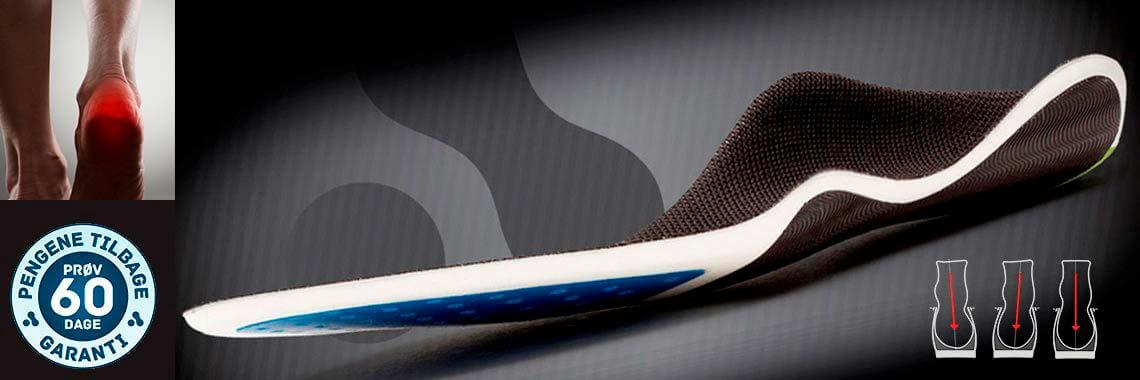
What is Pronation?
Pronation is a movement happening in your foot when walking, jumping and running at which ligaments and muscles that support the small bones in the foot, are being tensed up. When you set off again, this will trigger this energy, thus making the foot to act as a spring damper for the stresses, which might occur when you walk, jump or run.
All human beings are different: Some have soft feet, other rigid ones. The size of your arch underneath your feet varies greatly. When running, we all do it differently. All these differences cause variations in pronation.
Pronation is the foot’s natural shock absorption. If your pronation is not functioning optimally, you have a greater risk of damage. Excessive pronation can be a problem, since it stresses the ligaments and muscles in your feet and lower leg, the latter trying to stabilize the foot.
Pronation is a complex motion in the foot and ankle, which is controlled by both the joints and muscles in the foot, ankle and lower leg. This means that the muscles may become tired in the long run if you do not have proper cushioning and support for feet and ankles.

Pronation and running shoes – what to do:
Try on different pairs of running shoes at one of the many running stores or sports equipment stores. Many stores offer a good service. Choose the pair that fits best and is therefore most comfortable. The most important thing is that the shoes feel comfortable when you run. If you have a soft foot where the arch is flattened (flat feet), you may find that you pronate more than if you had a rigid foot with a high arch. If your usual running shoes tip inward and wear more on the inner edge of the heels, you may have strong pronation. To prevent excessive pronation, you will need support on the inside of your foot. If your running shoes tip outwards, and wear down most on the outer edge of the heel, you may have sufficient support on the inside. If you have too much support on the inside, you may need a softer, more neutral running shoe.
How can Align Footwear® insoles help you?
Align Footwear® insoles significantly reduce pronation. 80% of people in the world suffer some degree of over-pronation. Align Footwear® insoles adjust the foot into a more neutral position. Rather than place an artificial arch under the foot, Align Footwear® insoles seek to maintain the foot’s full mobility and activate the foot muscles.
In people who over-pronate, the source of the problem may seem to be the sole of the foot, but it is actually the ankle. When the ankle rolls inward, it forces the middle section of the foot and the forefoot into a sub-optimal position, adding to pronation or flat feet. The body then finds it more difficult to move forward, resulting in fatigue and biomechanical stress. Over-pronation can affect overall posture negatively and cause undue stress on ankles, knees, hips, neck and back.
Align Footwear® insoles significantly reduce pronation
80% of the population suffers from over-pronation to some degree. Align Footwear® insoles help to de-rotate and align the foot into a more neutral position. Unlike many competitor products, Align Footwear® insoles have no artificial arch under the foot. Our insoles control the ankle and optimize the body’s potential using the body’s own biomechanics.
In people who have excessive pronation, a flat foot or sole may seem to be the source of the problem. Pronation is a complex combination of movements of the foot and ankle. It begins with your talus, the dome that the long leg bone (tibia) rests on. When the talus rotates inward, the ankle shifts forwards and inwards, abducting the forefoot outwards, flattening the mid foot and pulling the heel bone outwards. The knee follows the same path. Your gait becomes much less efficient. The body has to work much harder to propel itself forward, resulting in fatigue and biomechanical stress. Excessive pronation can negatively affect overall body alignment and cause unnecessary strain on the ankles, knees, hips and spinal joints.
A study by Runner’s World’s third party expert, Dr. Martyn Shorten PhD, found that Align Footwear® insoles align the ankle into a more neutral state by up to 32%, decrease pronation up to 27%, and align the tibia (shinbone) into a more neutral position by up to 40%.
No other shoe insole company can match these statistics.

60-day Refund Policy
Full satisfaction or money back

You didn’t find an answer?
Call +45 22 633 633
or contact@alignfootwear.eu


